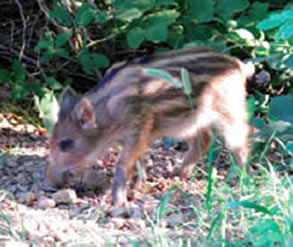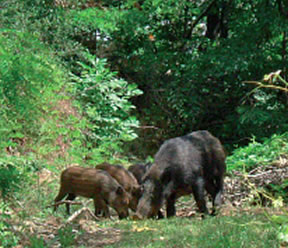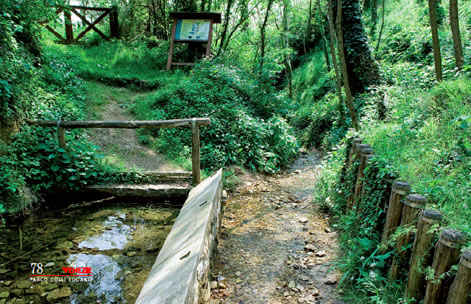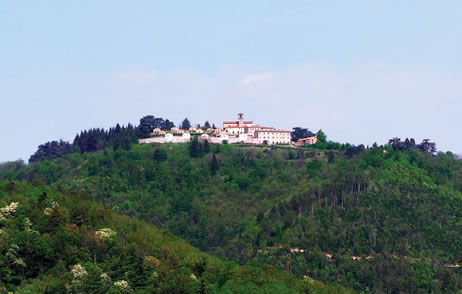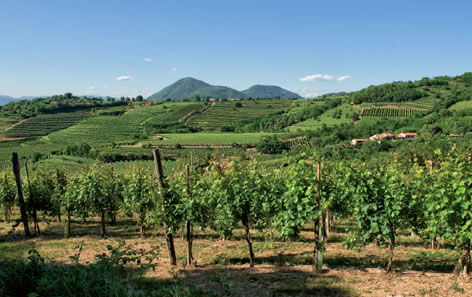MICHELE GALLODirigente unità complessa Agricolo Forestale del Parco Regionale dei colli Euganei
CINGHIALEUn intruso per gli equilibri e le attività del Parco
|
|
Da alcuni anni il territorio del Parco si è ritrovato, suo malgrado, ad ospitare un nuovo inquilino che ha creato e continua a creare non pochi problemi. Stiamo parlando del cinghiale (Sus scrofa L.), un mammifero che ha conosciuto negli ultimi decenni una considerevole espansione demografica in tutto il Paese.
In the past few years, the area of the park was found to hide a new "tenant" that has created and continue to create quite some problems. We are talking of the wild boar , a mammal that in the last decades has gone through a considerable demographic increase in the whole country. The first sighting inside the park dates back to 1997, probably a time when the first non authorized access of these species took place inside the protected area. Starting from this first original group, a population developed in the years to a significant number whose growth was maintained by many factors that in part characterize this unique area of Veneto, but unfortunately they also played in favor of these species that are not typically local. A hilly area with many woods, a rich variety of environment and arboreal shrubby species, a climate that is not so hard, with winters always less cold, a solid production activities of the local people tied up to the primary sector with productions of remarkable value (grapes, wines and olive oil); for these omnivore mammals, all this means to have large areas available for the daily rest, a very favorable climate, remarkable and various sources of food from nature (acorns, chestnuts roots, tubers, small insects) and from farmers (corn, vines, olive trees, etc.) which ensure a good variety of food through the whole year. To all this, just to understand how these animals have found here a small "happy oasis" so to speak .it is enough to add the total lack of natural predators and the fact that we are in a protected area where hunting is prohibited of course. All these favorable aspects, beside the fact that they contribute to ensure a good survival of these creatures they favor the breeding and as a consequence the number increase which in the past few years has really become exponential. This specie normally reproduce once a year with an average 5-6 piglets at each delivery, yet in the case of especially favorable conditions from the nutrition and climate point of view as in fact is the case of what happens in the Colli Euganei, females can deliver three time in two years and the number of wild boars can double from one year to the next. One can understand then how the problem of wild boars in this protected area might have reached exceptional levels in a very short period of time. In fact if on the one side these animals might look interesting and why not, in some case also fascinating and the subject of exciting educational starting points, on the other side they are a problem involving different aspects both from a nature and an anthropological point of views The main question is that the wild boar should exist in the Colli Euganei. A species was let in that in fact did not exist in the area if not many centuries ago and it is very important to consider that to introduce animals (and new species in general) in areas where these are not present involves a more or less deep upset of the delicate natural balance that in time were settled in those specific areas with consequences on greenery and the starting of new predatory balances and competitive behaviors with other animals. Parallel to the undisturbed growth the population that this member of the Suidae family was able to do inside the Park in the past few years, there has been registered an exponential growth of the damages caused to the natural environment and to the human activities. Something that causes serious problems is the rooting , that5 is the deep digging of the ground looking for food (tubers, root stocks, roots, underground animals). On the one side the aeration of the soil and the diffusion of some seeds is ensured , yet these things cause a change to the normal composition of the grass layer of the brushwood with a drop number of the most appetizing species and of greenery in general. Digging can also damage the plants that wild boars do not nourish themselves with , but their roots become exposed to air. Other plants that could be damaged also irreparably are those used to "scratch" and as structures that wild boars use to rub themselves or to free themselves from parasites after dipping in muddy pools; the constant scrubbing of animals cause the damaging of the barks with weakening and exposure to possible diseases leading to death the plants themselves. Another important matter related to the rooting activity and to the usual passage of these animals (trotting areas) is the heavy deterioration of the grass carpet deriving from that, with consequent erosion problems, made even worse, of course, by the deep slopes sometimes really remarkable of the hillsides. Even if there aren't yet studies about it, it is impossible not to consider the possible negative effect that these mammals could have on some other species such as birds, amphibians and reptiles and furthermore on vegetable and animal species of special interest protectionwise that are certainly not missing inside this Park. In a Park widely anthropized such as the one of the Colli Euganei it goes without saying that the damages that these animals cause to human activities are obviously serious too. Every year a certain number of request for compensation for damages to farming and cultivated land. The most damaged cultivations are corn, grapes, wheat, olive groves and orchards. Damages can occur in more cultivation stages and often besides the removal of part of the production there are several incredible indirect damages caused by the trampling and passage of the animals, from the fall of an entire plant (of corn for example) or the elimination of all the fruits (grapes for example) made just to eat only a small quantity of the fruits, to the plant damage, the deterioration of terraces or irrigation channel banks. Considering that very often farming can be the only income source of land owners, one can understand how the impact of this species represents a problem deeply felt by the residents to which there is to be added the emotional effect tied up with fears and worries as well as the developing of objections and contrasts between different bodies that at different levels are involved in the problem (Park administration, City councils, residents, hunters, farmers, etc.). Another important problem is also connected to night transit of these animals looking for food with obvious risk for the safety of the inhabitants or visitors of the Park. Therefore considering the serious impact that these animals are having on the natural ecosystems and on the lives of the inhabitants as well as the need to save them from a further worsening of the situation, it has become crucial to adopt some control measures that are mainly the capture and elimination of animals by using mobile traps (holes) run by the personnel of the Park. Obviously the decision to perform such a drastic measure was carefully considered and supported also by the evaluations and opinions as provided by the national Institute for Wildlife of Bologna, today named I.S.P.R.A. which works in cooperation with the Park. During the past two years many positive results were reached as far as the number of catches and one wishes that all this will lead to a real lessening of the damages. The most appropriate purpose to a situation like this would be the total removal of this not native species in order to restore in the best possible way the natural balance of the Park as it was before their arrival. Unfortunately it is a difficult target to reach due to the nature and biology of this species. The important thing is, in any case and in the meantime, to implement the best management of the area to allow these mammal to live in the best way possible with the existing wildlife and with all the elements that with their characteristics contribute to build the complicated and unique scene of this important protected area.
|
|
CA' EMO >>>>>
Potete ordinare la vostra copia del "Parco dei colli euganei" online oppure lo trovate in edicola e potrete godervi le immagini ad alta risoluzione. Contattateci per eventuali richieste.
 |
Le Tre Venezie Editoriale Via Zermanese 161, 31100 Treviso, tel e fax: +39 0422 404807 |


